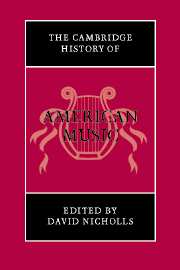Book contents
- Frontmatter
- PART ONE
- PART TWO
- 10 Music in America: an overview (part 2)
- 11 Immigrant, folk, and regional musics in the twentieth century
- 12 Popular song and popular music on stage and film
- 13 The rock and roll era
- 14 Ragtime and early jazz
- 15 Jazz from 1930 to 1960
- 16 Jazz since 1960
- 17 Tonal traditions in art music from 1920 to 1960
- 18 Serialism and complexity
- 19 Avant-garde and experimental music
- 20 Tonal traditions in art music since 1960
- Bibliography and references
- Index
- References
17 - Tonal traditions in art music from 1920 to 1960
from PART TWO
Published online by Cambridge University Press: 28 March 2008
- Frontmatter
- PART ONE
- PART TWO
- 10 Music in America: an overview (part 2)
- 11 Immigrant, folk, and regional musics in the twentieth century
- 12 Popular song and popular music on stage and film
- 13 The rock and roll era
- 14 Ragtime and early jazz
- 15 Jazz from 1930 to 1960
- 16 Jazz since 1960
- 17 Tonal traditions in art music from 1920 to 1960
- 18 Serialism and complexity
- 19 Avant-garde and experimental music
- 20 Tonal traditions in art music since 1960
- Bibliography and references
- Index
- References
Summary
It seems a virtually inevitable development that the creative explosions taking place in the realms of American jazz, popular, and theatrical music following World War I would find a parallel in the sphere of American art music. It also follows that much of the new art music would draw direct or indirect inspiration from those exciting and novel developments in the vernacular areas. Sometimes this took the form of direct stylistic mimicry or evocation, and other times it came across more subtly as an attempt to emulate, in art music terms, the sense of an original, energetic American identity that characterized the best of the new vernacular musics.
The prosperous United States of the 1920s proved an ideal environment for a flourishing of concert music. There was a significantly wide bourgeois audience, interested in “culture” and with money to spend, and a striking growth in upper-class financial support for art music performing organizations, concert series, and individual efforts and events – offered through personal, charitable, and corporate sources. The emergence of the United States as a world presence in the aftermath of World War I was an equally important stimulus to creativity in the art music sphere. American composers became abruptly aware of the inspiration and challenge presented to them by developments in European modernism, at the same time that they sought to establish a new and distinctive identity for American music, an identity that would speak both to their native audiences and to the world.
- Type
- Chapter
- Information
- The Cambridge History of American Music , pp. 471 - 495Publisher: Cambridge University PressPrint publication year: 1998
References
- 1
- Cited by

